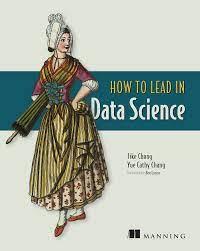
How to Lead in Data Science
Jike Chong and Yue Cathy Chang. 2021. Manning Publications Co. [ISBN 978-1-61729-889-9. 514 pages, including index. US$59.99 (softcover).]
Many recent advancements in our world are data science (DS) applications in industry/academia. In healthcare, genomics/virus research relies on vast databases to make life saving vaccines for public health. Handheld devices may soon transform the way healthcare operates by transmitting real-time data. In the field of artificial intelligence, the neural net is only as effective as the “learning” it does with data input to “teach” it how to conduct its task. These applications support the relevance of How to Lead in Data Science to create, organize, and manage leadership in the field. For this reason, it is a needed resource for an expanding industry.
Jike Chong and Yue Cathy Chang state that they authored this book for data scientists. Lay readers may have difficulty with the book yet are encouraged to scan through it as it can serve as a generic management guide. This book describes concepts that are universal to other technical fields, which makes it useful across all industries besides the growing DS field. “The contribution of DS to the economy is still in its infancy as of 2021. According to LinkedIn Talent Solutions data, the discipline has found the most traction in IT, computer software, and internet industries” (p. 412). Growth in the data scientist field is occurring in financial services, banking, insurance, health care, biotech, pharmaceuticals, and fitness, and is likely to increase quickly due to delays in current product pipelines. “The scarcity of data product manager talent is a significant bottleneck for companies looking to develop data and intelligence-driven products and features” (p. 454).
The initial chapters introduce real-life data scientists at varying levels of their career development. Each scientist is analyzed according to their positive performance and areas of needed growth. The authors tie these examples to detailed graphs of the progressive levels of data science advancement. The book uses the TEE-ERA fan (Technology, Execution, Expert Knowledge, Ethics, Rigor, Attitude) in Figure 2.1 of Chapter 2, which also appears on the inside of the back cover. The authors refer to these capabilities and virtues at all levels of the data scientist’s development from a strong technical lead to a manager to a director and, finally, to arrive at the executive level of performance. (The authors also outline a second career track as the path of an individual data scientist outside of management.)
Although How to Lead in Data Science emphasizes that technical knowledge and expertise are foundational to DS, these are the bare minimum skills for survival. The authors sprinkle advice throughout the book with tips for thriving in the field with the most important being to select an industry you like and will grow to love. Only with this affinity can you develop proper relationships with others, remain positive, keep current on technical advances, and keep a relevant skill set for influencing and inspiring an industry. The bottom line is to prove that data can bring impact and success in data science through this detailed guide. Who could go wrong!
Julie Kinyoun
Julie Kinyoun is an on-call chemistry instructor at various community colleges in Southern California. An avid reader, she enjoys reviewing books that help her become a better educator.
